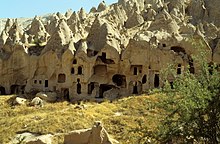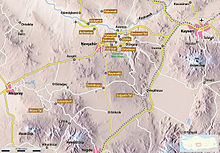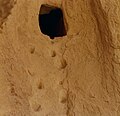Zelve
Zelve (also Eski Zelve , German Alt-Zelve ) is a place consisting almost entirely of caves in the Turkish region of Cappadocia in the province of Nevşehir . The no longer inhabited place is now an open-air museum.
history
Zelve was probably already settled in Roman times and over the years also served the Byzantines , Seljuks , Ottomans , Greeks and Turks as accommodation. In addition to various churches, there is also a mosque. It was not until 1953, after more and more of the caves collapsed due to earthquakes and erosion, that the last inhabitants were relocated to a newly built village called Yeni Zelve (Neu-Zelve , today Aktepe) , which was built with state aid . In 1967 the site was declared a museum.
construction
The area consists of three valleys, the walls of which are completely criss-crossed with caves that were carved into the soft tuff by the residents . These include apartments, utility rooms, churches and a large monastery complex. Almost all rooms are connected to one another by corridors and tunnels, some of which can be closed by the rolling stones typical of Cappadocian caves. The inspection is not easy, the outer entrances are sometimes steep stairs or just grips that are carved into vertical walls. The inner connections are narrow corridors, some of which go vertically through the rock and can only be climbed using recessed steps and grips. The fairy chimneys and dovecotes with painted entry holes typical of Cappadocia can also be found in Zelve. From the middle to the first (southern) valley, a tunnel over a hundred meters long, still accessible today, leads through the rock. A boulder between the first and second valley, on which the Geyikli Kilise (Church with the Deer) was located, collapsed in 2002. Since then, parts of the site have been closed to visitors.
buildings
The churches are not as splendidly decorated as in Göreme , which is why they are dated to the time of the iconoclasm or shortly before it (8th to 9th centuries). They show simple paintings and relief decorations carved out of the rock. A carved cross can often be seen in connection with archaic symbols. In the north, the third valley, there is a double church, consisting of the Balıklı Kilise (Church with the Fish) and the Üzümlü Kilise (Church with Grapes). The main room of the former has three apses , there is a relief cross on the ceiling and a cross medallion between two fish on the walls. In the Üzümlü Kilise, in addition to the eponymous grape decor, remains of figurative representations can be seen, including a Madonna with child and the Archangels Gabriel and Michael above the entrance. In the valley opposite is the badly damaged Direkli Kilise (column church).
On the walls of Vaftızlı Kilise are (Taufkirche) in the central valley blind niches , at the rear wall two crosses. The Geyikli Kilise, which has since collapsed, between the first and second valley, had a carved ceiling cross and an alleged representation of a deer, which in reality probably showed a lamb.
In the first valley on the south side at a height of about ten meters there is a monastery in the wall, the small rooms of which with the narrow and winding corridors form a complex labyrinth. On the opposite side of the valley is a mosque with a barrel vault carved from the rock . The front facade and the associated small minaret are the only brick buildings on the entire site.
literature
- Peter Daners, Volker Ohl: Cappadocia . Dumont, 1996, ISBN 3-7701-3256-4
- Marianne Mehling (ed.): Knaur's cultural guide in color Turkey . Droemer-Knaur, 1987, ISBN 3-426-26293-2
- Michael Bussmann / Gabriele Tröger: Turkey. Michael Müller Verlag 2004, ISBN 3-89953-125-6
Web links
Coordinates: 38 ° 40 ′ 9 ″ N , 34 ° 51 ′ 51 ″ E





